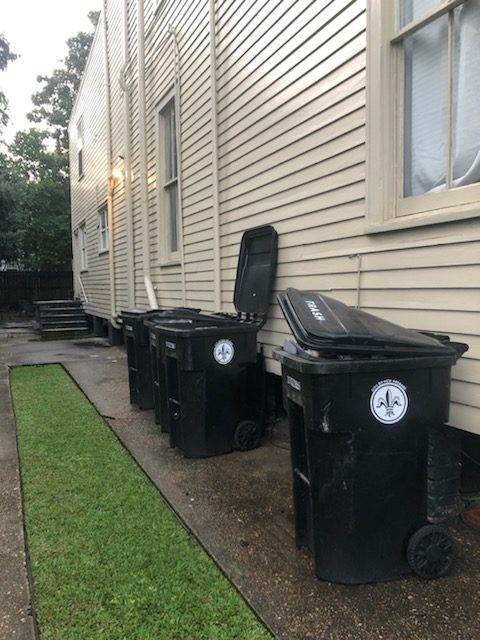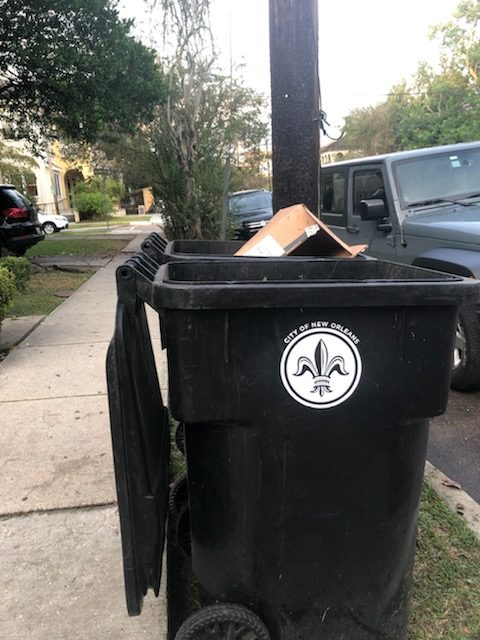Editor’s Note: The following series “Big Easy and the Environment” is a week-long series curated by Lindsay Hardy as part of the Digital Research Internship Program in partnership with ViaNolaVie. The DRI Program is a Newcomb Institute technology initiative for undergraduate students combining technology skillsets, feminist leadership, and the digital humanities.
This grouping of articles explores and appreciates New Orleans’ changing environment as it relates to film in the past, present, and future. “Reduce, Reuse, Recycle in New Orleans?” was originally published on NolaVie by Myles Edmund on January 21st, 2020. This article dives into the recycling desert that is New Orleans. It researches ways that New Orleans has worked to improves the recycling situation, as well as how it can continue to improve the cities environment.
After spending a summer at home in Miami, and dutifully separating my waste into paper, plastic, glass and other garbage, I returned to New Orleans. Like clockwork, I ordered takeout from Chipotle. My meal, chicken and rice and a bottle of water, arrived alone with a napkin, plastic fork and plastic knife. After I scarfed it down, I went to throw away the garbage, and suddenly a wave of guilt came over me. Where was the recycling bin?
In my New Orleans home, we don’t have one either. We just dump everything together in one big container — everything from food and plastic, to whatever else has been discarded, which in a college house can be literally almost anything. And this lack of waste care goes beyond my personal situation.
When driving down the Uptown campus area, walking to class, and most importantly taking out my garbage, there was not a blue recycling bin in sight. All of a sudden, something that should have been obvious to me before came to me out of nowhere in a “blind realizationism” – no one in my neighborhood appears to recycle. Blind Realizationism, a term I coined to describe the sensation when a person is told something, or sees something about a particular topic or person and all of a sudden they can’t get it out of their head and will never un-notice it.

Photo by: Myles Edmunds
“According to an analysis by personal finance website WalletHub (released April 2018), Louisiana ranks second-worst among U.S. states when examining a wide range of environmental indicators, including water and air quality, energy use and recycling” (1). The push to recycle seemed promising back in 1989, when Louisiana “jumped into household recycling … with a state law requiring that local communities reduce the volume of garbage going to landfills by 25% in three years” (2). Unfortunately, recycling now appears to be headed in the wrong direction. Republic Services of New Orleans, one of the largest waste companies, announced earlier this year that it would no longer be accepting recycling, stating “[t]here simply are no longer markets in this region for the excessively contaminated recyclables brought to our facility” (2). Likewise, in 2019, New Orleans officials “announced its curbside program will no longer pick up most categories of plastic” (6). According to Mayor LaToya Cantrell’s office, ”Residents should no longer place plastics #3 through #7 in their recycling bins … and they will no longer be accepted at the city’s Recycling Drop-Off Center on Elysian Fields Avenue (6). These include, “clear plastic food wrapping, cooking oil bottles, children’s and pet toys, bubble and blister wrap for packaging” (6).

Trash bins Uptown
Photo by: Myles Edmunds
The problem is not solely recycling, because recycling is just one factor that adds up to larger environmental problems. Not reducing our carbon footprint can lead to global climate change, which “is expected to affect temperature and precipitation patterns, oceanic and atmospheric circulation, rate of rising sea level, and the frequency, intensity, timing, and distribution of hurricanes and tropical storms” (8). According to an article on NOLA.com, “1991 remains the rainiest year on record for New Orleans, with more than 102 inches falling in the city that year, overwhelming the drainage system during the evening commute, flooding neighborhoods and leaving commuters and damaged vehicles stranded on neutral grounds” (5). These rains can be compared to the seriousness of the August 2017 storms (5). Summers in New Orleans, more specifically August, have the highest amount of precipitation. In stark contrast, during August 1950 (back when less garbage was made) “the average monthly rainfall was 3.88 inches” (10). Further research shows that the wettest days in New Orleans’ history range from the 1980s to now (9). This can prove a direct correlation between rainfall and trash. Louisiana is “at exceptional risk from climate change effects,” which are expected to result in “a greater number of intense rainfall days” and “increasingly warmer temperatures,” according to the federal National Climate Assessment Report (12). In an article in the Tulane Hullabaloo, it is suggested that New Orleans is not blatantly avoiding its environmental issues on purpose, it is just “lost in a sea of other issues” (4). This city, known to embrace its carefree and fun-loving spirit, holds a special place in my heart, but it needs to be held accountable for its actions or lack thereof toward the environment. According to an article on NOLA.com, “Louisiana is the second-worst in environmental friendliness” (1).
Many communities are starting to move away from a strategy focused primarily on recycling to one that incorporates the other two “Rs” – reduce and reuse. Tulane has implemented many options to “lighten your load” on campus. For instance, implementing “single-use bags, PJ’s reusable mug policy, OZZI reusable container program, and their trash to treasure program for reducing waste” (14). Many colleges are switching to all “green” campuses as well. For example, American University in Washington D.C. is officially “100% waste free” (3). They’ve made small changes that have had large impacts. For example, “Green buildings incorporate energy efficient technologies and a focus on human health. Environmentally conscious grounds management means (they) plant local and adaptive species. (They) use solar energy, strive for zero waste, and work with community partners to offer sustainable transportation” (13). In addition, they’re now the first University in the U.S. to go carbon-neutral (13). Starting by “composting all paper towels from restrooms on campus and all kitchen waste from three dining areas. Bottled water and food trays have also gotten the ax, cutting waste by 32%. Auto lubes are recycled, furniture is recycled or reused, and kitchen grease is recycled for electricity” (3). These are great options to reduce many forms of waste. If Tulane were to implement more of these policies on campus and make the effort to be “100% waste free,” it would be a great example for the rest of the City of New Orleans. Creating traction by starting out small, hopefully it would spread to nearby restaurants, bars and neighborhoods, with the end goal of a more eco-friendly city.
Sustainability is something we need to strive for as a community. It can be defined as “responsible use of resources over an indefinite period of time. Responsible resource use has become increasingly important as the human population continues to grow and consume natural resources at unprecedented rates” (7). It is imperative that we all do our part. Examples of turning a daily lifestyle more sustainable include: turning off all the lights when leaving the house, taking shorter showers, using reusable containers for food on the go, and unplugging devices when not in use. For instance, in her article “I do not drive in the South … And here’s why,” Frances Roberts-Gregory explains that she does not drive in New Orleans, in part because she is “adverse to owning a car because of the impact of oil and gas on frontline communities of color … due to the energy companies’ heavy polluting” (11). It is our generation that now needs to do everything it can, individually and collectively, to protect the environment, before it has a blind realizationism that it is too late.
Sources:
Times Picayune, 17 Apr. 2018, https://www.nola.com/news/environment/
article_7e6bdf06-5205-5d4d-9ef0-5b3d5346e16c.html). Accessed 16 Oct. 2019.
Times Picayune, 4 May 2019, www.nola.com/news/business/
article_e0f572ae-4df9-5cc1-9875-1c3e36bf0880.html. Accessed 16 Oct. 2019.
www.thebestcolleges.org/11-college-recycling-programs-that-put-all-others-to-shame/. Accessed 16 Oct.
2019.
4 .Krantz, Jon. “New Orleans needs to acknowledge its environmental issues.” Tulane
Hullabaloo, 14 Sept. 2018, tulanehullabaloo.com/42818/views/
new-orleans-needs-to-acknowledge-its-environmental-issues/. Accessed 16 Oct. 2019.
Times Picayune, 12 Jan. 2018, www.nola.com/news/weather/
article_7da3a9a4-fe30-5a45-97ba-3d2abc87ba75.html. Accessed 30 Oct. 2019.
Times Picayune, 17 May 2019, www.nola.com/news/business/
article_e0f572ae-4df9-5cc1-9875-1c3e36bf0880.html. Accessed 16 Oct. 2019.
vol. 71, no. 5, 2009, pp. 267–268. JSTOR, www.jstor.org/stable/27669428.).
8. Michener, William K., et al. “Climate Change, Hurricanes and Tropical Storms, and Rising Sea Level in Coastal Wetlands.” Ecological Applications, vol. 7, no. 3, 1997, pp. 770–801. JSTOR, www.jstor.org/stable/2269434.
louisiana/louis-armstrong-new-orleans-intl. Accessed 30 Oct. 2019.
united-states/louisiana/louis-armstrong-new-orleans-intl/august/1950. Accessed 30 Oct. 2019.
www.vianolavie.org/2019/09/27/i-do-not-drive-in-the-southand-heres-why/. Accessed 30 Oct. 2019.
12. Schleifstein, Mark. “Climate report: Louisiana, Southeast at exceptional risk through end of century.” NOLA.com / The Times Picayune, 30 Nov. 2018, NOLA.com / The Times Picayune, 17 May 2019, https://www.nola.com/news/article_b186a466-8b17-5f68-a2bd-64b080ac5686.html. Accessed 29 Oct. 2019.
2019.
campusservices.tulane.edu/content/lighten-your-load. Accessed 16 Oct. 2019.
 NOLAbeings
Multimedia artist Claire Bangser created NOLAbeings as a portrait-based story project that marries...
NOLAbeings
Multimedia artist Claire Bangser created NOLAbeings as a portrait-based story project that marries...
 Data corner: Adobe Suite (create a PDF, social media graphic, presentation, edit a photo and video
Data corner is where you go to work with analytics and top tech skills. It takes on everything from PERL and SQL to Canva and Sprout Social.
Data corner: Adobe Suite (create a PDF, social media graphic, presentation, edit a photo and video
Data corner is where you go to work with analytics and top tech skills. It takes on everything from PERL and SQL to Canva and Sprout Social.
